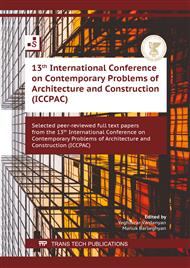[1]
M. Major, I. Minda, Drgania i oddziaływania dynamiczne na budynki i budowle, Zeszyty Naukowe Politechniki Częstochowskiej, Budownictwo 22, 2016, pp.223-237. (In Polish).
DOI: 10.17512/znb.2016.1.22
Google Scholar
[2]
D. Mrozek, Nieliniowa analiza numeryczna dynamicznej odpowiedzi uszkodzonych budynków, Silesian University of Technology, PhD Thesis, Gliwice, Poland, 2010. (In Polish).
Google Scholar
[3]
T. Friis, E.I. Katsanos, M. Saberi, H. Holger H. Koss, Two-level friction damping and its application for passive multi-functional vibration control of high-rise buildings, Engineering Structures, vol. 239, 112310, 2021, https://doi.org/10.1016/j.engstruct.2021.112310.
DOI: 10.1016/j.engstruct.2021.112310
Google Scholar
[4]
I. Mualla, H. Koss, Vibration control of novel passive multi-joints rotational friction dampers, Ce/papers, 1, 1473-1482, 2017, https://doi.org/10.1002/cepa.190.
DOI: 10.1002/cepa.190
Google Scholar
[5]
M. Armali, H. Damerji, J. Hallal, M. Fakih, Effectiveness of friction dampers on the seismic behavior of high rise building VS shear wall system, Engineering Reports, vol. 1, 5, 2019, https://doi.org/10.1002/eng2.12075.
DOI: 10.1002/eng2.12075
Google Scholar
[6]
M. Jafari, A. Alipour, Methodologies to mitigate wind-induced vibration of tall buildings: A state-of-the-art review, Journal of Building Engineering, vol. 33, 101582, 2021, https://doi.org/10.1016/j.jobe.2020.101582.
DOI: 10.1016/j.jobe.2020.101582
Google Scholar
[7]
A. Farshi Homayoun Rooz, A. Hamidi, A numerical model for continuous impact pile driving using ALE adaptive mesh method, Soil Dynamics and Earthquake Engineering, vol. 118, pp.134-143, 2019, https://doi.org/10.1016/j.soildyn.2018.12.014.
DOI: 10.1016/j.soildyn.2018.12.014
Google Scholar
[8]
A. Colaço, P. Alves Costa, C. Mont'Alverne Parente, A. Silva Cardoso, Ground-borne noise and vibrations in buildings induced by pile driving: An integrated approach, Applied Acoustics, vol. 179, 108059, 2021, https://doi.org/10.1016/j.apacoust.2021.108059.
DOI: 10.1016/j.apacoust.2021.108059
Google Scholar
[9]
ARAMIS User Manual, GOM mbH, Mittelweg 7-8 D-38106 Braunschweig.
Google Scholar
[10]
Z.L. Kowalewski, L. Dietrich, M. Kopeć, T. Szymczak, P. Grzywna, Nowoczesne systemy optyczne w badaniach mechanicznych – budowa, działanie, zastosowania, XXII Seminarium Nieniszczące Badania Materiałów, Zakopane, Poland, 2016. (In Polish).
Google Scholar
[11]
C. Ajdukiewicz, M. Gajewski, P. Mossakowski, Zastosowanie systemu optycznej korelacji obrazu ARAMIS, do identyfikacji rys w elementach betonowych, Transcomp – 14th International Conference Computer Systems Aided Science, Industry and Transport, Transcomp, Zakopane, (2010).
Google Scholar


